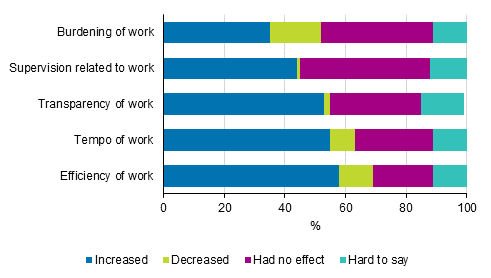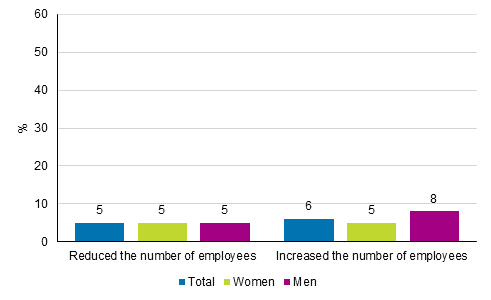Published: 11 December 2019
Digitalisation has penetrated Finnish working life
According to Statistics Finland’s 2018 Quality of Work Life Survey, 90 per cent of wage and salary earners use digital applications at work. The use of digital devices, personal digital skills and personal experiences of how digitalisation affects work are, however, distributed unevenly.
In practice, all upper-level employees used digital applications or devices in their work in 2018. The corresponding share for manual workers was 73 per cent. The most commonly used digital applications were real-time messaging tools, such as various chat applications.
Good one-third (35%) of those using digital applications and devices felt that the digitalisation of work had increased the burdening of work, but one in six (17%) felt that the burdening had decreased. Over one-half of respondents felt that digitalisation had increased the efficiency, tempo and transparency of the work. Good one-third (36%) feel that the possibility to use creativity in their work had improved.
Effect of the use of digital applications and devices on work, share of wage and salary earners using digital applications

Women felt that digitalisation had increased the burdening and tempo of work more often than men, men, in turn, felt it had increased the efficiency of work and the ability to use creativity in work more commonly than women. The experience of implementation of digital applications was more negative among local government wage and salary earners.
Digitalisation has a dual effect on the number of employees
Seven per cent of wage and salary earners worked directly with robots. As a rule, the experience was that robots had made work easier. Around one-quarter of those working with robots felt that the robots had freed up time for more interesting tasks.
Five per cent of all wage and salary earners said that the number of employees at their workplace had decreased in the past three years as a result of digitalisation or robotisation. On the other hand, six per cent said that the number of personnel had increased for the same reason.
Effect of digitalisation or robotisation on the number of employees at the workplace over the past three years, share of wage and salary earners

Statistics Finland's quality of work life surveys describe changes in wage and salary earners’ working conditions for over four decades, since 1977. The latest Quality of Work Life Survey shows that working life has developed positively in many respects: for example, wage and salary earners’ views on the atmosphere in the workplace, realisation of gender equality and social relationships in the workplace have improved clearly starting from 2008. Work engagement has increased. On the other hand, problems with coping at work have increased clearly from 2013. These problems are clearly more common among women than men. Various physical and mental symptoms have become more common, especially among young and middle-aged wage and salary earners.
Source: Quality of work life 2018, Statistics Finland
Inquiries: Hanna Sutela 029 551 2907, Anna Pärnänen 029 551 3795, Marianne Keyriläinen 029 551 3656, tyovoimatutkimus@stat.fi
Director in charge: Jari Tarkoma
Publication in pdf-format (165.6 kB)
- Tables
-
Tables in databases
Pick the data you need into tables, view the data as graphs, or download the data for your use.
Updated 11.12.2019
Official Statistics of Finland (OSF):
Quality of work life [e-publication].
ISSN=2342-2890. 2018. Helsinki: Statistics Finland [referred: 15.12.2025].
Access method: http://stat.fi/til/tyoolot/2018/tyoolot_2018_2019-12-11_tie_001_en.html

